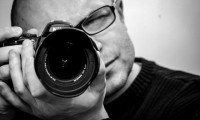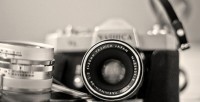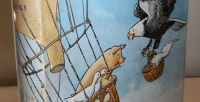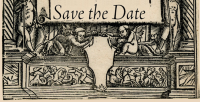The fourth installment of Kaitlin Manning's series on taking better pictures of rare books and ephemera. No matter what kind of camera you use, there are a few basic practices you can apply before you start shooting to improve the look and quality of your images (and to avoid fixing time consuming mistakes later on). While it is true that editing programs like Lightroom, Photoshop, and Gimp can work wonders and correct a myriad of errors, you will want to spend as little time as possible in these programs, especially if you are dealing with hundreds of photos at a time. Starting with good quality images from the beginning will eliminate the need for major edits -- and this begins before you even click the shutter. Make sure you have enough light. I've covered the basics of putting together a home studio in a previous post, but let me reiterate the need for good, diffuse light now. If your photos continuously look dull or underexposed, consider adding more light to the scene, but always make sure that it is properly diffused (i.e. there needs to be something translucent between the light and the object). Bare bulbs look harsh, create shadows, increase glare, and can either wash out or obscure details. Invest in a tripod. This was also mentioned briefly in a previous post, but let me elaborate a bit here: if you don't have the steadiest of hands and/or you routinely shoot manually in low speeds (generally less than 1/60 of a second) a tripod is a must. Camera shake can make you... [more The Savvy Bookseller: Tips and tricks before you shoot]
Bookselling
Job Posting: Historical Documents Dealer in Westport, CT Seeks Researcher with 3+ Years’ Experience
By Susan BennePrivate company in Westport, Connecticut seeks a researcher with exceptional organizational skills for small, friendly, fast-paced office that specializes in historical documents, books, and artifacts. Auction expertise a plus. Must be able to work quickly and accurately in cooperation with other staff members in a variety of roles. Excellent written and verbal communication skills a must. Responsibilities include research of new acquisitions for database and website, coordination of in-house auctions, representation at prestigious shows and exhibitions. Proficiency in computer databases, internet, and social media skills are necessary. Bachelor's degree plus three years' experience. Salary range: $40,000-$60,000 yearly. Please send resume to: Loraine@universityarchives.com. [more Job Posting: Historical Documents Dealer in Westport, CT Seeks Researcher with 3+ Years’ Experience]
The third installment of Kaitlin Manning's series on taking better pictures of rare books and ephemera. After buying a camera, learning how to use it, and setting up your home studio, the natural next step is to actually start taking photos, right? Ah, would that it were! One very important and often overlooked step for those new to digital photography is to consider how you will process and store your images, otherwise known as creating a “workflow.” This is a crucial step. Your workflow will encompass the entire lifecycle of your images, from calibrating your camera to archiving your files, and therefore must be considered carefully. You will want to commit your workflow to paper, listing out each step of your process so that you can refer back to it, maintain consistency, and ensure fast and easy image retrieval later on. Ideally, you would carefully plan out your workflow before you even take your first image; in reality, you probably already have a bunch of images on your computer organized in a (more or less) logical way, but which probably do not follow a rigid set of rules. For the moment, don't worry about the images that you already have – focus on a fresh start. Later on, once you have a solid system in place and as time allows, you may want to consider updating your old files to match your new, gloriously organized ones. Below is a very brief overview of the basic questions you must consider for a robust and efficient workflow. This is by no means an exhaust... [more The Savvy Bookseller: Establishing a Photography Workflow]
Since 1975 the William Reese Company has served a large international clientele of collectors and private and public institutions in the acquisition of rare books and manuscripts and in collection development. With a catalogue inventory of over forty thousand items and a general inventory of over sixty-five thousand items, we are among the leading specialists in the fields of Americana and world travel, and maintain a large and eclectic inventory of literary first editions and antiquarian books of the 18th through 21st centuries. Our offices are located in downtown New Haven, Connecticut and are open by appointment only. The William Reese Company is seeking to add a new team member to its Americana Department. This person needs to be detail oriented, personable and outgoing, and willing and able to lift reasonably large boxes of books. A foundational knowledge of American history is a must, as is a basic grounding in bibliographical knowledge. Previous experience in antiquarian book selling or library work is preferred but not essential. Excellent communication skills, both oral and written, are necessary, as is proficiency in the use of databases. The job description includes a range of the many tasks required in running a large rare book business, but primary duties are cataloguing and researching new inventory; working with customers and selling books in person, on the phone, and by catalogue or internet listing; maintaining inventory control; and possible travel to attend... [more Job Posting: William Reese Co. Seeks Rare Book Cataloguer in Americana Department]
Please join us on October 21st at 3pm ET to honor this year's prizewinners of the National Collegiate Book Collecting Contest's Susan Tane Prize for Student Book Collectors by Zoom. In addition to the awards, the Library of Congress' Chief of Rare Books and Special Collections Division, Mark Dimunation, will interview each winner. To attend, you must register for the Zoom meeting at this link. First Prize Daria Rose Evdokimova (Harvard University) "Ardis Publishers and the Immigrant Identity" Second Prize Francesca Mancino (Case Western Reserve University) “Reassessing Modernism: Women Writers and Publishers of the Lost Generation” Third Prize Austin Benson (University of Virginia) “The Little Office of Our Lady, 1599-1966: Online Book Collecting During the COVID-19 Pandemic.” Essay Prize Elizabeth Propst (Harvard University) “How Much Am I Bid for the Moon?: Collecting Poetry on the Cheap” With thanks to our colleagues and judges from the Fellowship of American Bibliophilic Societies (FABS), the Grolier Club, and the Center for the Book and the Rare Books and Special Collections Division (the Library of Congress) for making the contest happen once again, and to Susan Tane for funding the prizes. We look forward to seeing you there. NCBCC Award Ceremony Registration [more National Collegiate Book Collecting Contest Awards on October 21]
About us James Cummins Bookseller is one of the leading antiquarian book dealers in the United States. Founded in 1978, the company operates an open shop on the Upper East Side of Manhattan as well as maintaining several warehouses containing 500,000 books in New Jersey. We are book lovers and sell to like-minded private collectors and institutions all over the world. What we are looking for We are seeking a high energy, solution-oriented person to manage the bookkeeping, administrative and marketing components of both James Cummins Bookseller's gallery and online presence. This individual is comfortable dealing with financial data of a small company, is very detail oriented, can manage multiple simultaneous projects, has strong writing and interpersonal skills, a friendly disposition, and an interest in old books. The position will be responsible for overseeing the accounts payable and receivable and conducting other tasks related to the financial well being of the company, including managing our accounts with vendors, auction houses, and other dealers; will be diligent at recording data and have an ability to produce and understand financial reports; additionally, will create content for and manage the online marketing for the company. The position requires close collaboration with other members of staff as well as regular correspondence with our accountants, fellow dealers and clients. Responsibilities Track expenses, check writing, budget, taxes, cash flow, receipts and o... [more Job Posting: James Cummins Bookseller, Inc.]
University Archives of Wilton, Connecticut, among the fastest-growing historical autograph and rare book businesses, is seeking an experienced cataloguer familiar with the full range of material handled by the firm: letters, documents, manuscripts, autographs, archives, relics, ephemera and rare books in all areas. The ideal candidate will have strong writing skills, as well as knowledge of descriptive cataloguing. Online auction and retail sales experience or related experience is essential. Information about our company is available on the web. This is a full-time position. Salary plus benefits and bonuses provide a package in excess of $60,000 or higher, dependent on experience. Please send CV and references to Loraine Cordes at Loraine@universityarchives.com [more Position Open at University Archives]
What new additions to the abaa.org website caught the eye this week? Signed books from James Baldwin, Annie Leibovitz, and P.L. Travers, as well as several classic children's books, among other interesting items... If Beale Street Could Talk (Signed) by James Baldwin New York: The Dial Press, 1974. First Edition. Hardcover. Very Good. Signed by Author. First edition. Copy #6 of 250 specially bound copies signed by the author on the rear limitation page. 197 pp. Leather lettered in gilt in original brown cloth slipcase. Near Fine with slightly foxed edges and light rubbing to gilt, in Near Fine slipcase. A novel by the African-American expatriate, the basis of an upcoming film directed by Barry Jenkins. Offered by Burnside Rare Books. Annie Leibovitz: Photographs 1970-1990 (Signed, first edition) New York: HarperCollins, 1991. First edition, limited. Hardcover. Fine. SIGNED. Folio in grey cloth, housed in black cloth slipcase featuring large image of Leibovitz's famous John Lennon and Yoko Ono Rolling Stone cover photo. Light shelfwear to slipcase; light bump to front board lower corner, else book itself is As New. Specially bound and slipcased first edition, signed by Leibovitz and hand-numbered Copy 187 of 300 on the limitation page. Offered by Ken Sanders Rare Books. Visions Of Cody by Jack Kerouac (Introduction by Allen Ginsburg) New York: McGraw-Hill, 1972. First edition. Hardcover. Near Fine/very good. 8vo. 398 pp. Introduction by Allen Ginsberg. A novel written in the e... [more Books of the Week]
WHO OWNED THIS? Libraries and the Rare Book Trade consider issues surrounding Provenance, Theft and Forgery. A symposium presented by the International League of Antiquarian Booksellers (ILAB), the Antiquarian Booksellers' Association of America (ABAA) and the Grolier Club. -- Speakers and more detailed information will be published shortly. Information When: March 5, 2019 Where: Grolier Club, 47 East 60th Street, NY 10022 Cost: Free for ILAB affiliates and guests, reservations required Organized by the International League of Antiquarian Booksellers (ILAB). For more information or to RSVP contact: Angelika Elstner (secretariat@ilab.org). [more Who Owned This? A Symposium]
I've been a full-time antiquarian bookseller for over two years now, specializing in selling original materials that tell interesting American stories, with an emphasis on social movements. So my every day involves intellectual adventure as I make a living helping to preserve bits of history. Until the first week of January though, I hadn't quite experienced anything like I'm about to share, so with all due respect to Mr. Everitt, I couldn't think of a better title. I hope you'll keep reading and agree. It started the morning of Christmas Eve a couple weeks ago, when an eBay seller listed several books by the important civil rights activist, W.E.B. Du Bois. Du Bois was a prolific writer, and his books are not uncommon. But, what made these special was they had their dust jackets -- which I knew were rarely seen for these particular titles. The seller also listed a few other scarce African-American pieces, so I sent an email asking if there was anything else. 90% of the time I send an email like that the answer is "no." The other 10% will occasionally involve interesting pieces. I was having dinner at a restaurant with my family later that evening when I heard back from the seller, and his response almost caused me to choke. The seller had bought a storage unit that included the contents of several generations of a black family from Ohio, where at least two women attended Wilberforce University (the first black-owned-and-run university in the United States) and one of the men ... [more Adventures of an Absent-Minded Treasure Hunter]






